1. Rich fen and flush
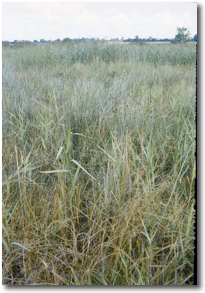 Alkaline (rich) fen is an
Annex 1 habitat (7230) under the EU Habitats Directive. Saw sedge (Cladium
mariscus) fen, a particular type of rich fen, is a priority habitat (7210)
under the EU Habitats Directive.
Alkaline (rich) fen is an
Annex 1 habitat (7230) under the EU Habitats Directive. Saw sedge (Cladium
mariscus) fen, a particular type of rich fen, is a priority habitat (7210)
under the EU Habitats Directive.
Rich fen and flush are peat forming wetlands that receive mineral nutrients from sources other than rainfall, usually groundwater or flowing surface waters that are at least mildly base-rich or calcareous, and are usually found over areas of limestone bedrock. The substratum is waterlogged peat and this usually has a high mineral content.
Fens differ from bogs because they are less acidic and have relatively higher mineral levels. They are therefore able to support a much more diverse plant and animal community.
They occur in a variety of situations including valleys or depressions, valley head fens, within transition mire and tall reed beds, on the landward side of hard-water oligotrophic lakeshore communities, calcium-rich flush areas in blanket bogs, dune slack areas, fens adjacent to raised and blanket bogs, in turlough sites, depressions in limestone pavement and wet hollows in machair, and spring fed habitats including cliffs, and even saltmarsh.
Alkaline fen may also occur as a secondary regenerating habitat on mined out bog sites which have been excavated to the fen peat layer.
Vegetation is typically dominated by Black Bog-rush (Schoenus nigricans) and/or small to medium Sedges (grass like plants). Rich fen and flush can be important for orchids. A well-developed layer of brown moss is also characteristic.
Rich fen are also important habitats insects and for a number of rare snail species.
Like most peatland types in Ireland, fens have declined in extent mostly as a result of activities such as peat mining, agricultural drainage, infilling, and fertiliser pollution and eutrophication. Only limited measures have been introduced to address these damaging activities, which are likely to have increased in severity since the 1990’s.
2. Poor fen and flush
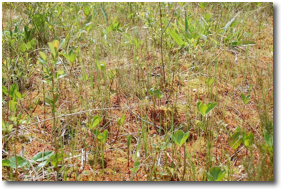 Poor fen and flushes include
peat-forming communities that are fed by groundwater or flowing surface waters
that are acid. In most cases the substratum is acid peat which has a higher
nutrient status than that of surrounding acid bogs. The vegetation of poor fens
and flushes is typically dominated by sedges and extensive carpets of mosses, in particular, Sphagnum moss.
Poor fen and flushes include
peat-forming communities that are fed by groundwater or flowing surface waters
that are acid. In most cases the substratum is acid peat which has a higher
nutrient status than that of surrounding acid bogs. The vegetation of poor fens
and flushes is typically dominated by sedges and extensive carpets of mosses, in particular, Sphagnum moss.
Poor fens occur in a variety of situations including areas flushed by moving water in upland and lowland blanket bogs, flushed depressions in grassland areas, cutover bogs and wet heath areas.
Like most peatland types in Ireland, poor fens have declined in extent mostly as a result of activities such as peat cutting and mining, afforestation, agricultural drainage, infilling, and fertiliser pollution and eutrophication.
3. Transition mire & quaking bog
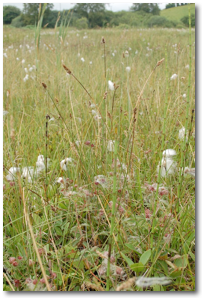 Annex 1 habitat (7140) under
the EU Habitats Directive.
Annex 1 habitat (7140) under
the EU Habitats Directive.
Transition mires and quaking bogs are peat-forming communities developed at the surface of waters with little or moderate amounts of nutrients, with characteristics intermediate between rich (alkaline) and poor (acidic) fen types. For this reason, they are considered as a separate habitat but they may occur within, or on the fringes of other peat-forming systems.
They present a large and diverse range of plant communities. In large peaty systems, the most prominent communities are swaying swards, floating carpets or quaking mires formed by medium-sized or small Sedges, associated with Sphagnum or brown mosses.
Transition mires and quaking bogs are usually associated with the wettest parts of a bog or fen and can be found in wet hollows, infilling depressions, or at the transition to areas of open water. The vegetation frequently forms a floating mat or surface scraw over saturated, spongy or quaking peat. Standing water may occur in pools or along seepage zones. The vegetation typically comprises species that are characteristic of bog, fen and open water habitats.
In some cases the mire occupies a physically transitional location between bog and fen vegetation, for example on the margin of a raised bog, or may be associated with certain valley and basin mires.
Like most peatland types in Ireland, transition mire have declined in extent mostly as a result of activities such as peat cutting and mining, afforestation, agricultural drainage and reclamation, infilling, and fertiliser pollution from adjacent farmland.
4. Calcareous springs
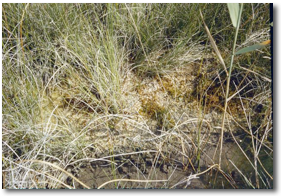 Priority habitat (7220) under
the EU Habitats Directive.
Priority habitat (7220) under
the EU Habitats Directive.
Calcareous spring fens develop around permanent freshwater springs or areas of water seepage that are especially rich in calcium. The upwelling of water is often associated with an interface between permeable and impermeable rock or soil layers. The water supply may be from upwelling groundwater sources, or from seepage sources or sometimes from geo-thermal sources. Petrifying springs may be closely associated with Alkaline fens but with less fluctuations in water. A key requirement is a steady flow of water, though this may dry up for short periods.
Springs are often very small features covering no more than some tens of metres. Petrifying springs occur on shallow peaty or skeletal mineral soils. On contact with the atmosphere at the spring head, carbon dioxide is lost from the water or is depleted by photosynthetic activities of plants growing in the spring, which results in the precipitation of a calcium bicarbonate marl or tufa crust. The vegetation in such areas, and especially mosses may be coated in a thick crust of lime. Larger petrifying springs may form tufa cones that constitute a singular habitat.
Springs occur in lowland and upland areas, are often very limited in extent and may be associated with a variety of different habitats such as alkaline fen, woodland, heathland, grassland, limestone rich boulder clay or gravel deposits or on exposed rock.
Spring vegetation is characterized by an abundant or dominant moss cover and may or may not be peat-forming. Calcareous spring fens are rare in Ireland.
As calcareous spring sites are often small in extent they are threatened by a range of land reclamation, turf cutting, and drainage activities, which can rapidly degrade their structure and function. Damage to this habitat type is likely to have increased in severity since the 1990’s due to these activities, which adversely impact on these small scale habitats.
5. Non-Calcareous springs
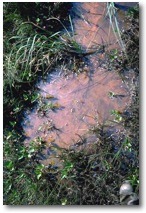
Non-calcareous springs that are irrigated and kept permanently moist by acidic to neutral water that is base-poor and typically oligotrophic. They may be associated with skeletal mineral or peaty soils. Vegetation is typically dominated by mosses and a few higher plant species.
Non-Calcareous Springs occur in lowland and upland areas, are often very limited in extent and may be associated with a variety of different habitats such as woodland, heathland, grassland, bogs, wet clay banks or gravel deposits or on exposed bare rock.
As these spring sites are often small in extent they are threatened by a range of land reclamation, turf cutting, afforestation and drainage activities, which can rapidly degrade their structure and function. Damage to this habitat type is likely to have increased in severity since the 1990’
For further information on these and other Irish wetland habitats, including the species that occur on them etc. the reader is directed to Fossitt, J. (2000) A Guide to Habitats in Ireland published by The Heritage Council, Ireland (You can download the Heritage Councils habitat key here).